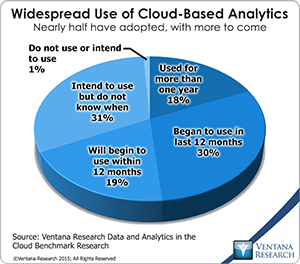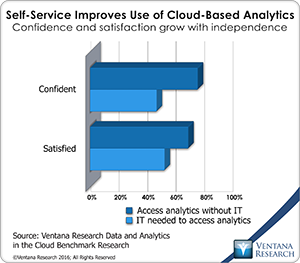You are currently browsing the tag archive for the ‘Cloud’ tag.
I recently attended Oracle OpenWorld for the first time in several years. The message at this year’s event was clear: Oracle is all in on the cloud. I had heard the message, but I didn’t get the full impact until I arrived at the Moscone Center in San Francisco. All signage at the event contained the word “cloud,” and Oracle issued 18 press releases in conjunction with OpenWorld related to cloud computing. I also found out that Oracle has its own definition of “cloud.”
Oracle now offers cloud services ranging from infrastructure as a service, which competes with Amazon Web Services, to database as a service to big data as a service to analytics as a service. These are in addition to Oracle applications offered in software-as-a-service configurations. Some years ago Larry Ellison expressed public resistance to “cloud computing”, but since then Oracle has been steadily investing in, adopting and now fully embracing it. Oracle’s direction reflects what our benchmark research has been showing for years: Cloud computing is being adopted ever more widely. For example, our Data and Analytics in the Cloud research shows that nearly half (48%) of organizations use cloud-based analytics today and virtually all (99%) expect to use cloud-based analytics eventually. The research also shows that one in four (24%) have the majority of their data in the cloud today and 86 percent expect the majority of their data to be in the cloud eventually.
In the big data and analytics market, Oracle offers the following cloud services:
- Oracle Exadata Cloud Service – massively parallel processing (MPP) SQL database
- Oracle Business Intelligence Cloud Service – business intelligence and visualization
- Oracle Big Data Cloud Service – Cloudera Enterprise (Hadoop) and data integration
- Oracle Data Visualization Cloud Service – self-service data visualization
- Oracle Big Data Preparation Cloud Service – self-service data preparation
- Oracle Big Data Discovery Cloud Service – data science with data preparation and visualization
- Oracle GoldenGate Cloud Service – data replication and streaming data
- Oracle NoSQL Database Cloud Service – key value store.
Oracle has also announced Oracle Essbase Cloud Service for multidimensional analysis and Oracle Big Data SQL Cloud Service for SQL on Hadoop and NoSQL. Oracle’s Big Data Compute Edition will allow organizations to scale Hadoop compute nodes and data nodes independently. All of these are indicated on the Oracle website as “coming soon.”
Faced with such a broad portfolio of big data and analytics capabilities, it may be a challenge for potential customers to understand the portfolio and decide which pieces are required for their organization. Fortunately, services based in the cloud are easier to try since no installation is required and subscription-based licensing doesn’t require long-term commitments to products.
Part of Oracle’s value proposition, based on its long devotion to the old model of on-premises licensing and management, is a mixture of cloud and on-premises deployments, often referred to as hybrid cloud. Oracle’s cloud services are available in three  configurations: as a public cloud service subscription; as a managed private cloud service subscription managed by Oracle in the customer’s data center; and licensed as an on-premises deployment managed by the customer. Oracle is betting that this flexibility with be attractive to enterprises as they make their journey to the cloud. Amazon, the key cloud competitor highlighted in Oracle’s keynotes, does not offer on-premises or hybrid configurations. Our research finds that nearly half (47%) of organizations support integration of cloud-based data with on-premises data and 38 percent vice versa, suggesting a significant presence of hybrid deployments.
configurations: as a public cloud service subscription; as a managed private cloud service subscription managed by Oracle in the customer’s data center; and licensed as an on-premises deployment managed by the customer. Oracle is betting that this flexibility with be attractive to enterprises as they make their journey to the cloud. Amazon, the key cloud competitor highlighted in Oracle’s keynotes, does not offer on-premises or hybrid configurations. Our research finds that nearly half (47%) of organizations support integration of cloud-based data with on-premises data and 38 percent vice versa, suggesting a significant presence of hybrid deployments.
We should note that most of Oracle’s big data and analytic cloud services are not new. In fact, most of Oracle’s portfolio competes with other products that have been in the market for years. Its strength is to excel at making products enterprise-ready. Others may find new and innovative ways to tackle computing challenges, but as these innovations take root in the market, Oracle adopts them, hardens them and makes them available for critical applications. It also adds innovations around the edges, but fundamentally Oracle makes these capabilities industrial-strength for dealing with issues such as security, reliability, manageability and governance – necessities that are often overlooked as new products come to market. If your organization needs to support mission-critical big data and analytics, I recommend you consider Oracle’s offerings. They have the breadth and depth to meet most needs.
Regards,
David Menninger
SVP & Research Director
Follow Me on Twitter @dmenningerVR and Connect with me on LinkedIn.
Cloud-based computing has become widespread, particularly in line-of-business applications from vendors such as Salesforce and SuccessFactors. Our benchmark research also suggests a rise in the acceptance of cloud-based analytics. We’ve seen the emergence and growth of cloud-only analytics vendors such as Domo and GoodData as well as cloud-based delivery by nearly all the on-premises analytics vendors. Almost half (48%) of organizations in  our benchmark research on data and analytics in the cloud are using cloud-based analytics today, and two-thirds said they expect to be using cloud-based analytics within 12 months. In fact, only 1 percent said they do not intend to use cloud-based analytics at some point. This popularity leads to the question of how to maximize the value of investments in cloud-based analytics. We assert that one of the most important best practices for cloud-based analytics is to empower business users with modern analytics tools they can work with without relying on IT.
our benchmark research on data and analytics in the cloud are using cloud-based analytics today, and two-thirds said they expect to be using cloud-based analytics within 12 months. In fact, only 1 percent said they do not intend to use cloud-based analytics at some point. This popularity leads to the question of how to maximize the value of investments in cloud-based analytics. We assert that one of the most important best practices for cloud-based analytics is to empower business users with modern analytics tools they can work with without relying on IT.
Part of the premise of cloud computing in general is to reduce reliance on in-house IT. Line-of-business groups are drawn to the cloud because it enables them to concentrate on the business at hand. They don’t have to wait for IT to set up systems and often can purchase cloud-based services without a capital requisition process. Not only do users want this independence, but cloud-based systems benefit IT, too, by reducing the administrative burden – there’s no need to acquire, install and configure hardware and the associated software. They also help reduce ongoing maintenance since some of that is the responsibility of the cloud application provider.
Cloud-based analytics have benefits that go beyond reducing the administration burden. Organizations in our research most often ranked first or second improved communication and knowledge sharing (39%), improved efficiency in business processes (35%) and decreased time to market (24%). In the context of cloud-based applications of any type, these findings should not come as a surprise. These systems enable access to data from any device in any location. Ready access to information should improve communication, efficiency and consistency. Workers can review and share information as they are performing their jobs in the field, on the shop floor, in the warehouse or when meeting with customers. In addition, more than half (52%) of organizations reported improved data quality and data management as a benefit.
For these and other reasons users want to be self-sufficient. Usability is consistently the most important software evaluation criterion in our various benchmark research studies.  In the data and analytics in the cloud research, usability was the highest-ranked of seven evaluation criterion: Almost two-thirds (63%) of participants said it is very important.
In the data and analytics in the cloud research, usability was the highest-ranked of seven evaluation criterion: Almost two-thirds (63%) of participants said it is very important.
However, the research also finds that most users do not access their cloud-based analytics without the help of IT. Only 40 percent said they are able to analyze their data by themselves. Is this important? If we look at the results organizations are able to achieve, the answer is yes. Those that operate without IT are both more confident (77% vs. 44%) and more often satisfied (71% vs. 55%) in their ability to use cloud-based analytics than those that do not.
As our research shows, the advent of cloud-based analytics is here. Empowering business users makes it possible to improve business outcomes. The IT organization will be free to focus its attention on critical issues only it can address. Thus modern tools for cloud-based analytics can benefit both the lines of business and IT.
Regards,
David Menninger
SVP & Research Director
Follow Me on Twitter @dmenningerVR and Connect with me on LinkedIn.

 LinkedIn
LinkedIn Twitter
Twitter Facebook Fan Page
Facebook Fan Page Ventana Research Website
Ventana Research Website